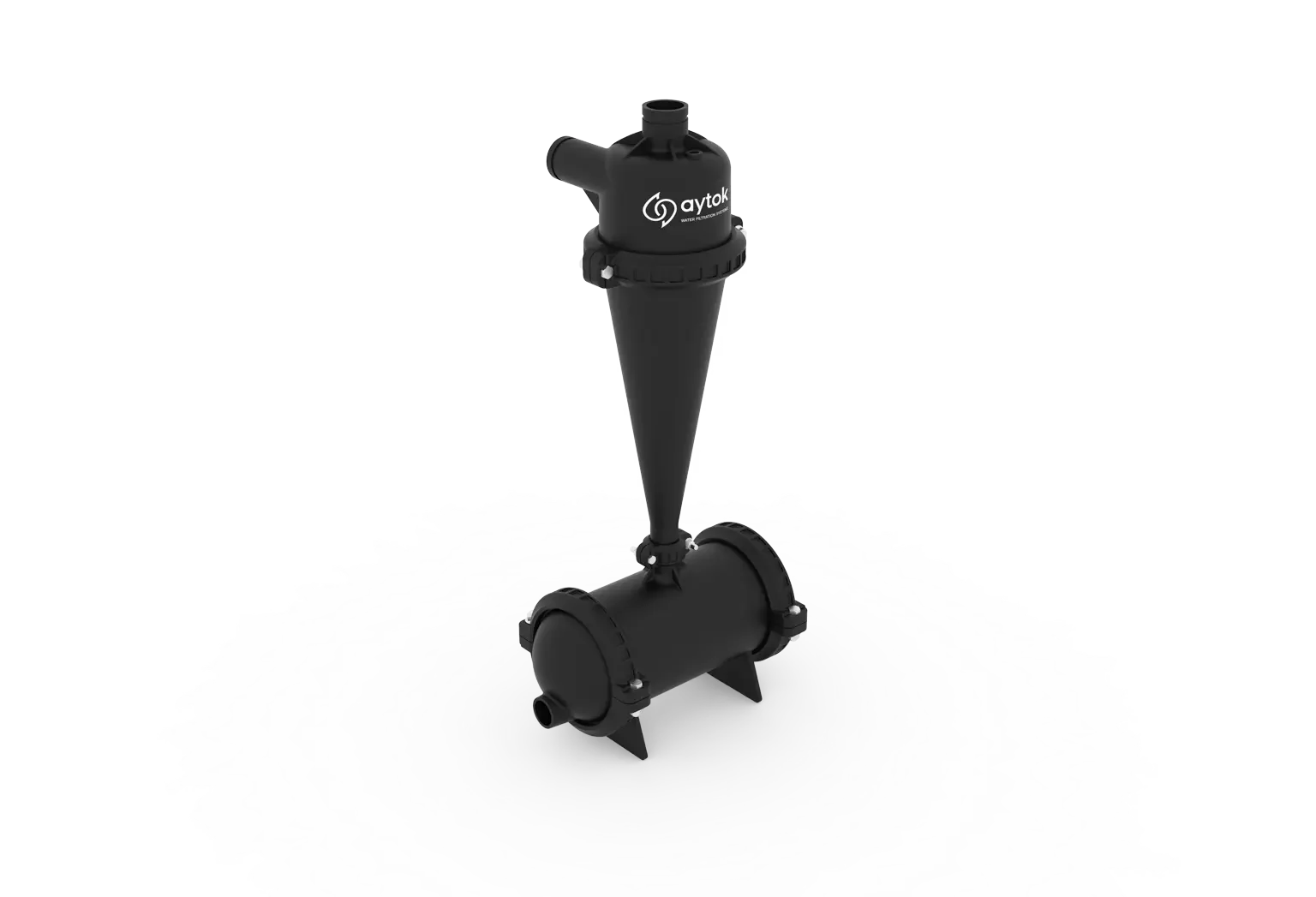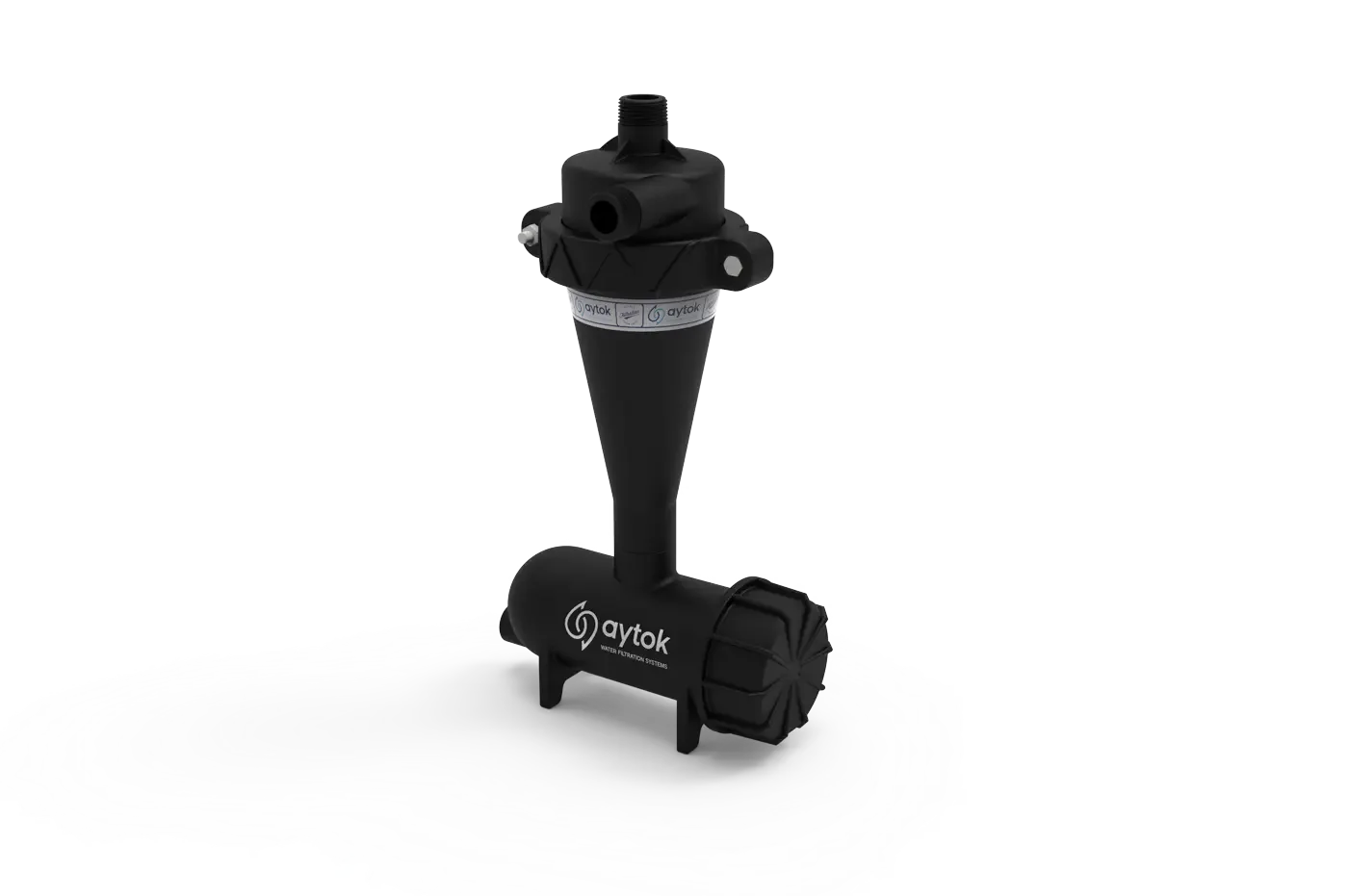| Body Material | PA6GFR30 |
| Maximum Working Pressure | 6 bar ; 87 Psi |
| Maximum Working Temperature | 60 °C ; 140°F |
| Minimum Flow Rate | P2010: 3 m³/h P2020: 15 m³/h P2025: 20 m³/h P2030: 25 m³/h |
Ürünlerimiz
water_drop Irrigation
Uygulama Alanları
water_drop IRRIGATION
Filter Türleri
Media Center


Cleaning Process
During filtration, solid particles accumulate in the collection tank at the bottom. This tank is periodically purged through a discharge valve. The valve’s operation can be either manual, requiring user intervention, or fully automatic, triggered by a controller.
Working Principle
Hydrocyclone filters separate suspended solids from liquids using the principle of centrifugal force, with no moving parts or filter media. When the water mixture enters the hydrocyclone's conical body at a high-speed, tangential angle, it creates a powerful swirling vortex. This rapid rotation throws heavier particles like sand and silt to the outer wall, where they spiral down to be collected in a separation tank at the bottom. Meanwhile, the cleaner, lighter water is drawn up through the center of the vortex and exits through the top outlet, ready for use.
Send us a message
Fill out the form below to contact us.
P20 Series - Plastic Hydrocyclone Filters
GENERAL FEATURES
| Body Material | PA6GFR30 |
| Maximum Working Pressure | 6 bar ; 87 Psi |
| Maximum Working Temperature | 60 °C ; 140°F |
| Minimum Flow Rate | P2010: 3 m³/h P2020: 15 m³/h P2025: 20 m³/h P2030: 25 m³/h |
ADVANTAGES


Cleaning Process
During filtration, solid particles accumulate in the collection tank at the bottom. This tank is periodically purged through a discharge valve. The valve’s operation can be either manual, requiring user intervention, or fully automatic, triggered by a controller.
Working Principle
Hydrocyclone filters separate suspended solids from liquids using the principle of centrifugal force, with no moving parts or filter media. When the water mixture enters the hydrocyclone's conical body at a high-speed, tangential angle, it creates a powerful swirling vortex. This rapid rotation throws heavier particles like sand and silt to the outer wall, where they spiral down to be collected in a separation tank at the bottom. Meanwhile, the cleaner, lighter water is drawn up through the center of the vortex and exits through the top outlet, ready for use.
Send us a message
Fill out the form below to contact us.
P20 Series - Plastic Hydrocyclone Filters
ADVANTAGES
The Sand Problem, Solved.
Abrasive sand and silt are the silent killers of filtration systems; the Aytok hydrocyclone is the definitive solution. It uses centrifugal force to eject heavy, damaging particles—with no screens to clean, no moving parts to fail, and no power required. This is where Aytok's engineering excels: its ultra-smooth inner surface captures even finer particles, while an optimized vortex design drops them into the collection tank with maximum speed and efficiency. By removing the heaviest load from the start, it drastically reduces wear on your main filters, saving you time, money, and maintenance. Its robust, corrosion-free plastic construction ensures a lifetime of reliable protection, making it the smartest investment for your system's health.
GENERAL FEATURES
| Body Material | PA6GFR30 |
| Maximum Working Pressure | 6 bar ; 87 Psi |
| Maximum Working Temperature | 60 °C ; 140°F |
| Minimum Flow Rate | P2010: 3 m³/h P2020: 15 m³/h P2025: 20 m³/h P2030: 25 m³/h |
Ürün Detayı


P20 Series - Plastic Hydrocyclone Filters
GENERAL FEATURES
Cleaning Process
During filtration, solid particles accumulate in the collection tank at the bottom. This tank is periodically purged through a discharge valve. The valve’s operation can be either manual, requiring user intervention, or fully automatic, triggered by a controller.
Working Principle
Hydrocyclone filters separate suspended solids from liquids using the principle of centrifugal force, with no moving parts or filter media. When the water mixture enters the hydrocyclone's conical body at a high-speed, tangential angle, it creates a powerful swirling vortex. This rapid rotation throws heavier particles like sand and silt to the outer wall, where they spiral down to be collected in a separation tank at the bottom. Meanwhile, the cleaner, lighter water is drawn up through the center of the vortex and exits through the top outlet, ready for use.
ADVANTAGES
Powerful Filtration, Smarter Design.
The Sand Problem, Solved.
Abrasive sand and silt are the silent killers of filtration systems; the Aytok hydrocyclone is the definitive solution. It uses centrifugal force to eject heavy, damaging particles—with no screens to clean, no moving parts to fail, and no power required. This is where Aytok's engineering excels: its ultra-smooth inner surface captures even finer particles, while an optimized vortex design drops them into the collection tank with maximum speed and efficiency. By removing the heaviest load from the start, it drastically reduces wear on your main filters, saving you time, money, and maintenance. Its robust, corrosion-free plastic construction ensures a lifetime of reliable protection, making it the smartest investment for your system's health.
